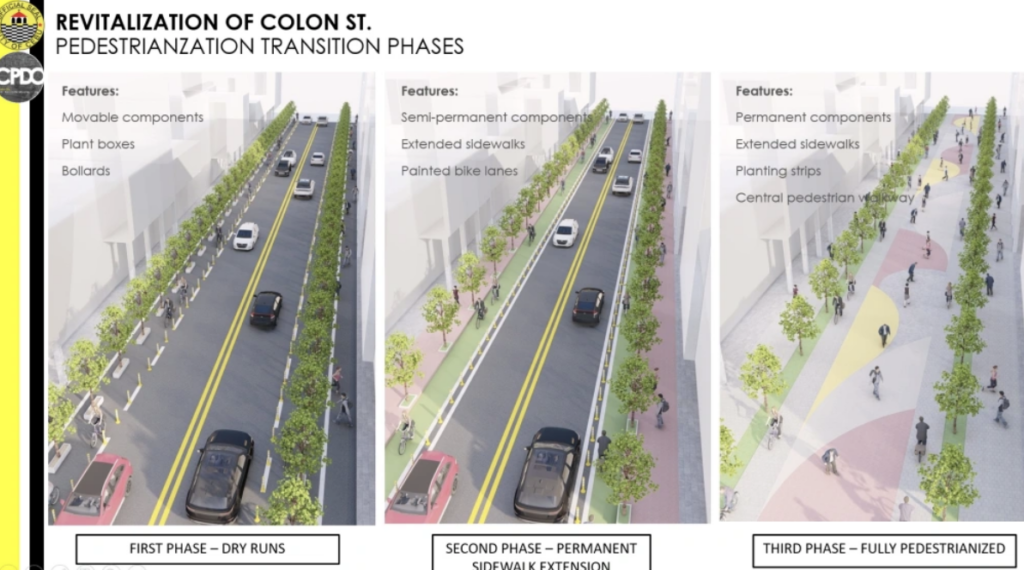
CPDO said it will implement the pedestrianization of Colon Street in three phases. | Photo credits: City Planning and Development Office (CPDO)/ Cebu City News and Information
CEBU CITY, Philippines – The newly installed chairman of the Cebu City Council’s Committee on Transportation has reservations about the proposed pedestrianization of downtown Cebu.
Cebu City Councilor James Cuenco, the chairman of the Transportation, Communication, and Other Utilities Committee, stated that while the city is not currently ready for pedestrianization, he pointed out that for now, it will be particularly challenging due to the climate in Cebu.
“I think we are not ready for pedestrianization, but I agree with the concept because eventually, we will get there. For now, it’s really difficult primarily because of the climate we have in Cebu,” Cueco said in an interview on July 4.
READ: Cebu City plans downtown pedestrianization with trees, walking paths starting year-end
CBRT ‘Link to Port’ project: No permit application yet, says CCTO
4 business owners in Cebu City slam CBRT ‘Link to Port’ project
Cuenco explained that while pedestrianization succeeds in countries with four seasons, our country experiences only rainy and dry seasons.
He added that climate change may contribute to extreme weather events, such as intense summer heat and heavy rains causing flooding, especially in Cebu.
“Due to climate change, [Cebu] experiences extreme weather conditions. When it’s summer, it’s very hot, and during the rainy season, the rain pours heavily, leading to flooding,” he said.
In Europe, pedestrianization has proven to be successful. For example, Copenhagen, Denmark, is renowned for its extensive pedestrian zones and cycling infrastructure.
The Strøget, one of the longest pedestrian streets in Europe, has boosted local businesses and improved the quality of urban life. Similarly, in Barcelona, Spain, the city has implemented superblocks, which are groups of city blocks where traffic is limited, allowing more space for pedestrians and cyclists.
Moreover, Cuenco said that if they want to start the pedestrianization, particularly the ‘Link to the Port’ feature of the Cebu Bus Rapid Transit (CBRT), which aims to complement the proposed pedestrianization of the city, he urges the CBRT management to complete the long-delayed Package 1 before starting new projects.
“I suggest that before [reinstalling] the lampposts and improving the sidewalks, they should first finish the main component of Package One, which is the BRT road because it has been long delayed,” he said.
Cuenco also suggested that if pedestrianization is aimed at preserving heritage sites, authorities should refrain from closing Osmeña Boulevard.
Instead, he proposed focusing on areas like Colon Street, the Basilica, and Magellan’s Cross because closing or pedestrianizing Osmeña, being a major thoroughfare, Cuenco said would likely cause significant traffic congestion and accessibility issues for commuters.
He agreed with Lawyer Kent Jongoy, assistant department head of the Cebu City Transportation Office (CCTO), who recently said that the area, given the current transportation services, is not ready for closure for pedestrianization.
On July 2, Jongoy stated in a media forum that Cebu is not prepared for closure for pedestrianization due to the current state of transportation services.
He noted concerns about potential accessibility issues, where he pointed out that Osmeña Boulevard serves 60 to 70 percent of jeepney routes, as well as numerous businesses and schools.
“I am against the timing and timeliness of the pedestrianization. I agree with the CCTO that we are not ready, at least not for the whole stretch of Osmeña Boulevard. If we proceed with pedestrianization, it should be done on adjacent [roads],” Cuenco said. /clorenciana